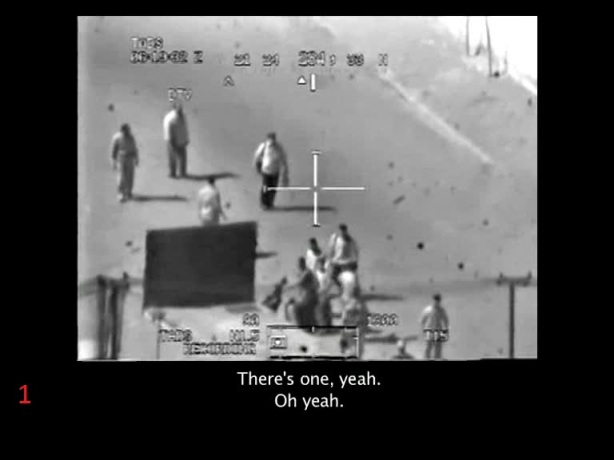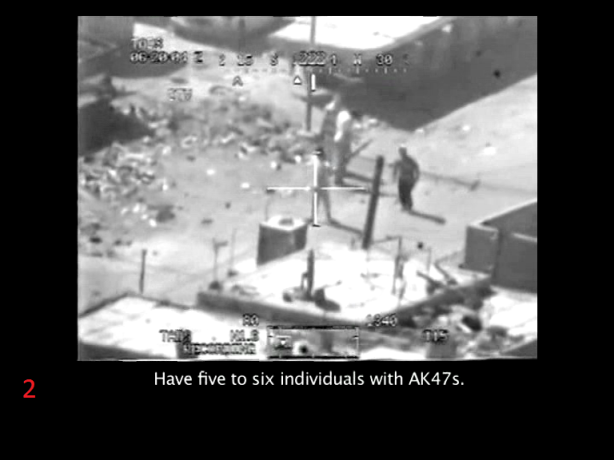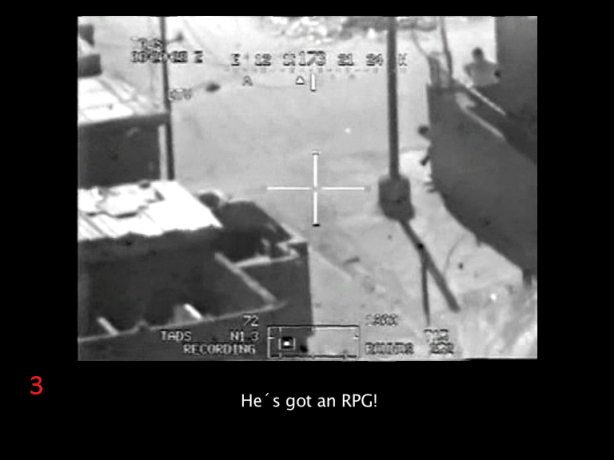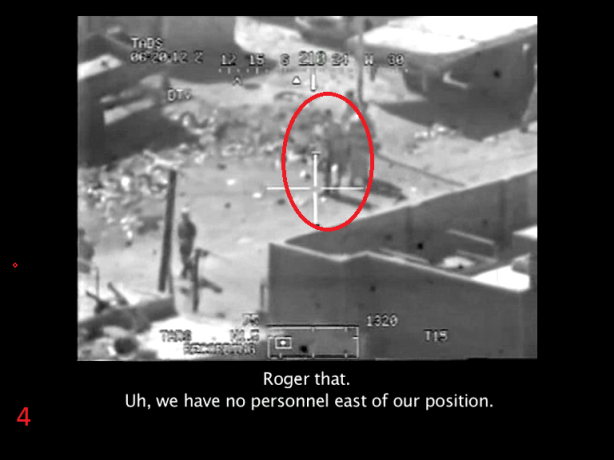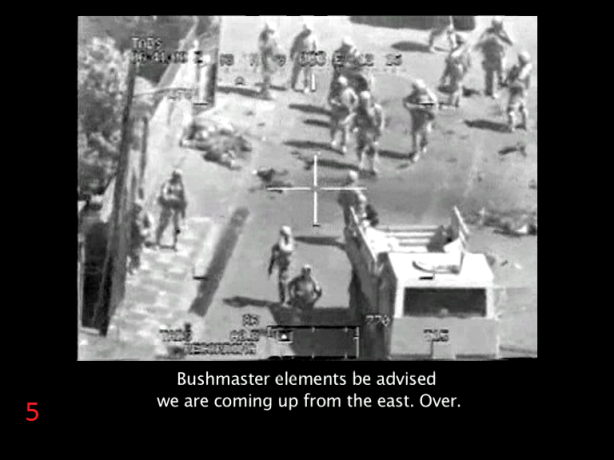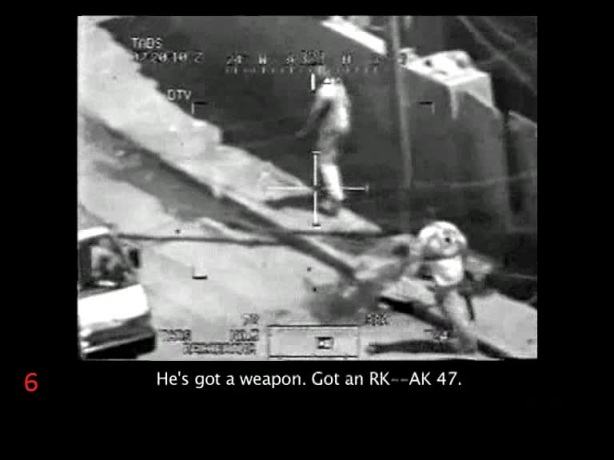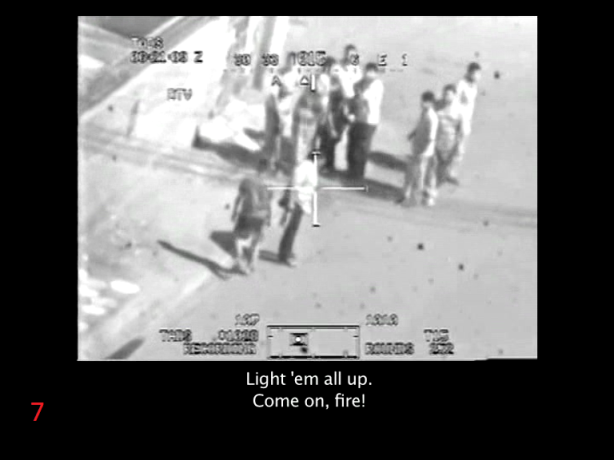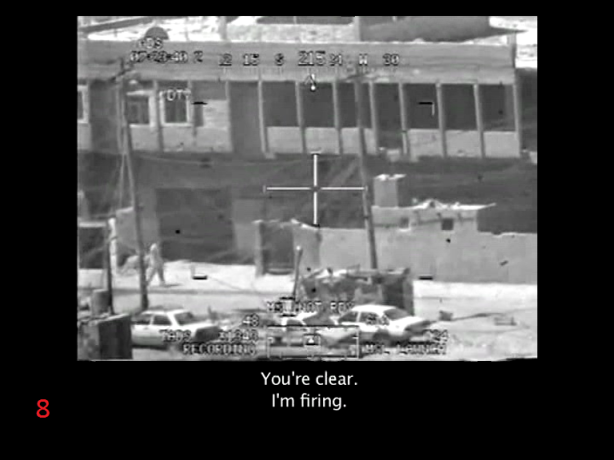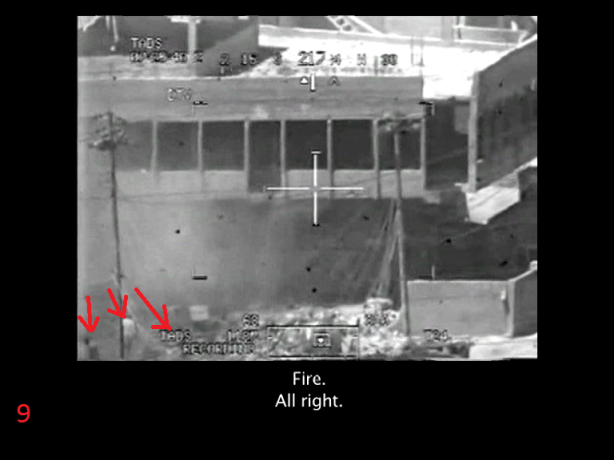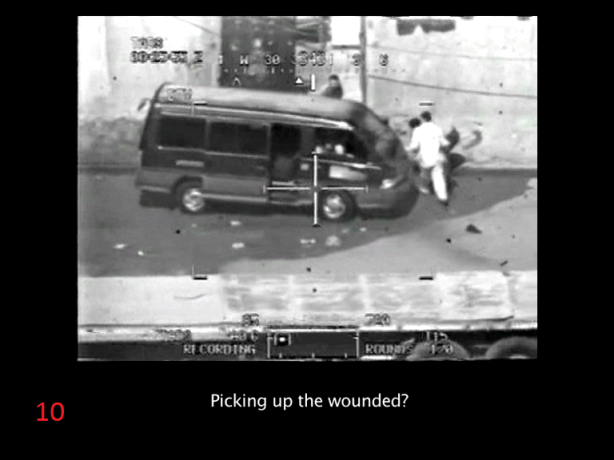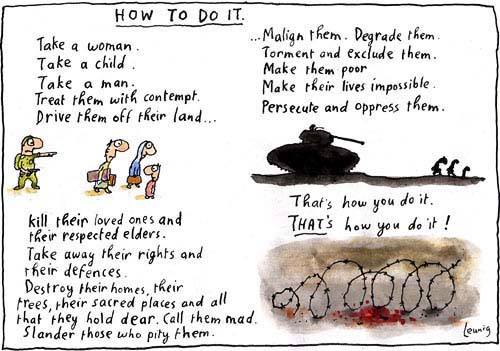[Warning: this is satire. I apologise for any confusion. If I offend anyone I want to make absolutely certain that they are the right people.]
In 2006 The Lancet published the second of two ideologically driven mortality “surveys” which claimed that the US had caused over 600,000 deaths in Iraq. This was followed by other such “research” conducted by those who made no effort to conceal their own political bias against George W. Bush’s decision to invade Iraq. Some of these organizations claimed to have found astronomical numbers of fatalities, even over a million. One of those who has led the fight to correct these subjective and biased studies is Jim Slobberdrib. For eight years Slobberdrib headed Applied Research Science Enterprises prestigious Iraq Death List project. More recently Slobberdrib has overseen a new study which, by applying newer and even less biased techniques and standards, has found that US actions actually saved many thousands of Iraqis who would otherwise have perished. Since the release of these explosive findings Slobberdrib has been very busy promoting the work by granting interviews to the media. Fortunately, however, he was able to take time out from all of that in order to grant me an interview:
KK: If I could turn first to your work with the respected Iraq Death List project – how exactly did you get the inspiration to start the project, and what were its aims?
JS: Well, it is funny how inspiration can strike at any moment. I was working for Blush, McLieberger and Koch, the PR firm, and, I don’t know, I… I must have been quite dissatisfied with the meaninglessness of it. So much so, I think, that my boss could actually tell even before I really knew myself. He told me that I needed something more meaningful in my life, a chance to give back. As it happened, he said, our firm had a relationship Applied Research Science Enterprises…
KK: A relationship?
JS: Yes, I think they shared office space in Kuala Lumpur or something. And they shared other things – you know, photocopying costs, long-arm staplers and so forth. They also had the same Human Resources department, funnily enough. It worked out quite well for me in the end, because it meant that I could just stay on the payroll despite suddenly and drastically and ummm…
KK: Boldly?
JS: Yes, yes, boldly. Boldly changing my career completely. Of course, there was a significant pay rise and I think that this shows that being daring and taking risks can be quite rewarding in that sense. The rewards are more than merely material, they are also monetary.
Anyway, I am getting ahead of myself. Basically, I came up with the idea of doing a truly definitive body count in Iraq which would ensure that the Bush and Blair regimes were absolutely accountable for every single death of every single innocent but only if we could truly verify their innocence and their deadness. I believed utterly, then as now, that it would be wrong to hold someone accountable for abstract statistics, it is only when we can absolutely verify absolute innocence and absolute death that we can think of holding those in power accountable.
KK: So it was a sudden inspiration born out of an urgent humanitarian impulse?
JS: Exactly. They sent me along to meet the people at Applied Research Science Enterprises. They could also tell that I was stricken with a Humanitarian Impulse. They said it made me look troubled and intriguing. They mentioned that the main humanitarian concern in the world was probably the impact of the US invasion of Iraq and that people desperately needed reliable information to make judgements on the moral dimensions of the US action. I said something like: “Hey, wait a minute. If you guys are a research company, why not do some research about the effects of the invasion?” They were really impressed with my idea.
KK: So you didn’t have any directly training or experience as a statistician or epidemiologist or researcher of any sort did you?
JS: Yes, well, I think that this was the greatest strength that I brought to the job. I was an outsider, with a fresh perspective, not some stale old bean-crunching maths person. I wasn’t like The Count from Sesame Street being all mathematical about everything but losing sight of the human picture. I was there because of my Humanitarian Impulse and I could feel it getting stronger all of the time. Some people said I was becoming quite Bohemian. I even thought about writing a poem. I was the ideas man – the humanitarian ideas man. I could do the numbers too, if I wanted. I was used to it. In PR and marketing, we live by the numbers. I was never one of those people who actually makes the numbers, but I was around lots of numbers. Some of these numbers were really big numbers. I mean really big numbers, but they didn’t scare me. I can talk about infinity without getting scared.
KK: Walk us through what Iraq Death List actually did?
JS: Well, we collated reports of fatalities, but we would only actually include a reported fatality if it was independently verified by two Western media sources who had access to eyewitnesses of unimpeachable character. After that it was necessary for us to conduct our own independent verification to absolutely ensure that the eyewitnesses could be relied on.
KK: And then the first Lancet study came out in 2004. According to one of the researchers, they had initially expected that they might see an increase in mortality due to increased rates of disease or disruption to health and sanitation services, but instead they found that tens of thousands of people had been violently killed.
JS: Well, it just goes to show how political and unscientific they were. How are you going to show that someone died of disease because of the invasion? Did George W. Bush come up to them with a syringe full of dysentery or thyphus and inject them? A disease isn’t like a bullet. No one shoots someone with a disease. They were just going to count up some dead people and use some fancy number trick to say if was America’s fault. It’s like If I said that 78 percent of people who died of cancer died because they listened to rap music.
KK: But that wasn’t their main finding.
JS: Sure, but what they did was just as bad. They went around just asking Iraqis if anyone they knew had died and they just took their word for it that. These are Iraqis. They’re the ones who, I mean they’re practically the same people as… well, you know, they hate America. Of course they’re just going to say that the Americans killed my habeebi, or whatever. Hey, that reminds me of a joke a Marine told me: What did the Haji taxi driver say when he saw his child’s severed foot in the middle of the road?
KK: Umm, maybe just tell me later.
JS: Anyway, that wasn’t even the worst of it. They took those claims and then said that if these people said that their loved ones had died it must mean lots of other people had died well. They just made up all of these fictitious dead people. Completely made up. I don’t know how they thought they’d get away with this nonsense, but luckily we had our own definitive Iraq Death List and we could categorically refute their findings.
KK: So this is when you first began to clash with people like Gilbert Burnham and Les Roberts?
JS: Yeah.
KK: So, to set the scene, by this stage it is the end of 2004. A year and a half has passed since the invasion. What confirmed mortality figures did Iraq Death List have at this stage?
JS: That’s the amazing thing, these jokers were claiming that 100,000 people had died but our confirmed fatalities were zero.
KK: Zero?
JS: Yeah.
KK: That’s quite conservative.
JS: Thanks. Well, anyway you can imagine how ridiculous these people looked, claiming that these nameless 100,000 people had died when we could show that there were no confirmed deaths at all.
KK: But surely some people must have died by this stage.
JS: People die all the time, but none of these deaths could be properly confirmed as being the result of US actions and confirmed as being real.
KK: Being real?
JS: Yeah. I guess one of the greatest challenges we faced at that point was the security situation. Our confirmation protocol is rigorous and we often found it impossible to deploy the hologram team to the areas in which fatalities were witnessed.
KK: Hologram team?
JS: It was vital that we assured ourselves that eyewitnesses had in fact witnessed real events, in those cases where eyewitnesses were considered sufficiently credible. We had to eliminate the most obvious possibility – that eyewitnesses had in fact witnessed only a clever projection made with hologram technology. But, there were often unacceptable risks in deploying the team.
KK: You mean that these alleged fatalities tended to occur in violent hotspots, in neighborhoods that were too dangerous to send a team into?
JS: I mean in deploying the team to Iraq. It was a very violent place…
KK: Despite having no actual confirmed fatalities?
JS: I know what I’m saying. Let’s not forget that American heroes were dying there every day. If we’d actually had a hologram team, we could never have risked sending them to the country.
KK: You didn’t even have a hologram team?
JS: Apparently it is difficult to find personnel who are appropriately trained and qualified to analyze this sort of technology.
KK: Because it doesn’t exist?
JS: Well, it is definitely cutting edge technology, maybe a bit beyond cutting edge. Anyway, one of our interns proposed a workaround and the “powers that be” decided that this was the way to go. It was decided that a quick trip to the morgue would serve to confirm that the dead were not holograms but in fact corporeal. I was against the decision. You know, I could understand the public relations aspect to it. People were thinking that zero fatalities was too low a figure. Edward Bernays understood this sort of thing. He invented public relations and he knew that ordinary people were very stupid. He called the average man “Dumb Jack” and he would have understood that “Dumb Jack” would never accept that the most scientific and objective measure of fatalities in Iraq was no fatalities at all. I understood the PR aspect of it, but by this time I had my scientist hat firmly on my head and my scientist hat told me it was all wrong.
KK: This was quite a dark time for you, wasn’t it?
JS: Yes, I did suffer from this sense of being conflicted. I was haunted by a recurrent nightmare. I would see “Dumb Jack” who looked just like my dad in his work coveralls. Then “Dumb Tariq” the suicide bomber would come along and decapitate my dad while singing “I Got You Under My Skin” in Frank Sinatra’s voice. Then me and “Dumb Tariq” would kick the head around like a soccer ball. Suddenly I’d realize that all along, every time I opened my mouth a stream of foul brown liquid would gush out, as if I was literally spouting liquid diarrhea. My therapist told me that it meant that when confronting trauma I became fecund with insight.
KK: “Fecund with insight”?
JS: Yeah, full of it apparently.
KK: But eventually you adjusted?
JS: Things got worse before they got better. My proposal that we initiate a capture and release program where Arabs would be banded and, if feasible, microchipped did not go down well. Detractors said that having such a program in the continental US would be of little use in determining death levels in Iraq. I tried to point out that this very same technique had been invaluable in studying declining numbers among Whooping Cranes and that the Arabs in question must themselves be migratory, otherwise they would not be in the continental US if the first place. I was widely pilloried for these ideas. I guess, in hindsight, that I should have talked them through with someone before calling a press conference.
KK: So if we move forward to 2006, and the release of the second Lancet study, widely referred to as “L2”. They estimated a very high mortality at this stage. In fact they estimated around 650,000 excess deaths, with 600,000 due to violence. What was the death toll according to IDL at this time?
JS: In approximate terms it was roughly around 3.
KK: Could you be more precise?
JS: It was 3.
KK: So there was an even bigger difference between your figures than there had been in 2004?
JS: In absolute terms, perhaps, but in percentage terms the gap had narrowed and I…
KK: Sorry, you say the gap had narrowed? What to?
JS: Well, a little over 20 million percent. That sounds a lot, but remember that in 2004 the percentage difference between our estimates was infinity. Infinity is much much larger than 20 million. 20 million is nothing compared to infinity. It’s like comparing, say, the size of a tennis ball with, umm, I don’t know, something infinitely bigger than a tennis ball.
KK: The universe?
JS: OK, maybe not that much bigger, but you get the point. I was very alarmed by the way politics had interfered with our science as if we should just compromise our methods in order to fit in with some antiwar malcontents and their made-up death study. Still, a difference of 20 million percent was just enough to show people once again that the Lancet study was dangerous nonsense.
KK: And now the Democrats in Washington started to take notice?
JS: Yes, they realized that our confirmed and undisputed body count was an invaluable weapon against the President. Of course, Republicans were not happy with me at that point. Senator Oren Stretchy (R-KY) physically threatened me with a yoghurt at a breakfast meeting. Bill O’Reilly said he wanted to chop me to pieces with his hedge-trimmer and feed me to his neighbor’s dachshund, but I think he might have mistaken me for Bernie Sanders’ cousin.
KK: And then, of course, that all changed when Bush actually admitted that your figures were correct.
JS: It was a great moment. Not just for me. Not just for IDL. But for the entire country. The President himself came out and admitted three innocent people had been killed due to his actions. He had saved us from Saddam’s weapons of mass destruction and from the smoking gun that could come in the form of a mushroom cloud. He had finally brought the justice that would give peace to the restless souls of those lost on 9/11, in the Maine and at the Alamo. He had saved the lives of millions of Americans and the price he paid was to carry the burden of guilt forever for those innocent lives lost because of his actions. It was a great moment from a great leader.
You know, people like to compare Bush to Reagan or to Teddy Roosevelt, but to me his greatness transcends the parochial confines of US politics. If the great Winston Churchill and the beloved Mahatma Gandhi had through some miracle conceived a love child, that love child would be George W. Bush.
KK: This was, indeed, a great moment. Bush showed a humble and saintly side to himself that clearly moved people. But there were still those who questioned the actual figure of 3 killed, suggesting that it was on the low side. Perhaps if you gave more detail about IDL‘s methods. I mean, surely there must have been a lot more than 3 people confirmed killed in nearly 4 years of occupation.
JS: More “people” maybe. If you could call them that. But “people” could mean anything. “People” could be insurgents, or terrorists, or militant Islamic extremist fundamentalist Muslim militants. If you think those people are actual “people” then you go ahead and call them that. But you’ll excuse us if we don’t take the same stance. IDL was created out of a Humanitarian Impulse to definitively document the deaths of innocents so that the powerful can be held to account. You can’t treat the good killing, where we kill the bad guys, as being like the bad killing. In fact it should really be set up so that each good killing is subtracted from the number of bad killings.
KK: That would be another reason for saying that the US has killed a negative number of people. Sorry, I guess that is getting a bit ahead of your narrative.
JS: No, you are right though. The US has probably negatively killed much higher numbers of people than we outlined in our latest study. We should maybe revise our findings to take into account the negative killing aspect of killing bad guys. Sorry, where was I?
KK: I think you were about to outline the methods you used to make sure that you only counted the bad killing and not the good killing that we want our politicians to carry out.
JS: Oh, yeah. Right, you see the way I saw it was that we needed unimpeachable character witnesses who could testify to the goodness and innocence of the stiff. You see, one of the problems America faces is that its enemies don’t fight fair. They don’t wear uniforms. They don’t carry weapons. And they aren’t all military age males. You can’t even trust the kids and the babies. These people are so fanatical and so full of hatred that they sew explosives up into their own babies and then fire them out of modified mortar tubes. It was just the same in Vietnam. As one soldier said: “The old men, the women, the children – the babies – were all VC or would be VC in about three years. And inside of VC women, I guess there were about a thousand little VC now.”
KK: Who was that?
JS: That was Lieutenant William Calley. He had a breakdown, like combat fatigue, and then they just persecuted him because they needed some sort of scapegoat. Luckily President Nixon knew a thing or two about being the victim of a witch hunt, and he gave him a pardon.
Anyway, so we needed a way to tell who were the fanatic insurgent terrorist Islamists. In a real country we would ask the priest or the preacher, but obviously we couldn’t ask Muslim priests. We couldn’t say that they needed the testimony of a Christian priest either, because that might seem insensitive. I still thought that a respected religious figure was the right sort of person to give this testimony. It finally came to me that the ideal religious personage, who was not objectionable and who commanded very wide respect, was an ordained Tibetan Buddhist monk.
KK: So you would accept that someone who had been killed was, in fact, innocent if in life they had been known to an ordained Tibetan Buddhist monk who was prepared to vouch for their character?
JS: Obviously there is a fine balance that must be achieved here, but we thought that our approach was very reasonable.
KK: And do you still think it was a reasonable approach?
JS: Of course.
KK: Despite what occurred near Kut al-Farraj in mid-2008?
JS: I’m not sure what you are referring to.
KK: Perhaps I can refresh your memory. August the second? A village near Kut al-Farraj? An airstrike using multiple 500lb J-DAM against farm buildings which US personnel described as “hardened”? Surely you must remember that the official IDL mortality count jumped overnight from 4 to 179? Does it ring a bell yet? The airstrike at the village where the Venerable Abdallah al-Bakr happened to live?
JS: Yeah. I’ll never really get that. How can someone called Abdallah be ordained as a Tibetan Buddhist monk? Don’t you need to be Tibetan?
KK: No. Tibetan is also a type of Buddhism. Allen Ginsberg was an ordained Tibetan Buddhist monk.
JS: Wasn’t he some sort of Nazi or Communist or something?
KK: You’re thinking of someone else.
JS: Look, our results were sound and the Kut al-Farraj incident only strengthened the validity of our results. It showed that our method was flexible and responsive.
KK: “Strengthened the validity”? Are you really still defending this now? You had assured people for such a long time that the definitive and absolutely reliable death toll was 4 and suddenly almost in an instant it jumped by over 4000 per cent! How can you possibly justify that?
JS: Look, as a layman you might not understand that the best and most definitive figure isn’t some sort of happy medium that corresponds with common sense and accords with a full holistic picture of the context in which the events occur, it comes from taking the most narrow, restrictive and conservative approach possible. For a layman that might seem outwardly to throw up anomalies, like overnight jumps in the figures, but that is exactly how we ensure that our figures are utterly sound and definitive.
And anyway, a 4000 percent jump is tiny compared to a jump of infinity.
KK: This isn’t even particularly relevant because the percentage jump is actually the least of the problems with the new tally.
JS: I know where you are going with this. I just want to say that we had been using a set statistical method for years. We produced the definitive mortality data using that method and as I said before just because the method throws up results which, to a layman might seem really stupid, that does not invalidate the method.
KK: You know what I’m going to ask. The 175 killed Kut al-Farraj in 2008 – were they people?
JS: Look these were 175 certified innocent lives lost. I mean, the word “people” could, you know…
KK: Were they human?
JS: Not as such.
KK: They were…?
JS: OK, they were ducks.
KK: They were ducks. Innocent ducks maybe, but they weren’t people.
JS: Well, from the perspective of an ordained Tibetan Buddhist monk they actually are people.
KK: Alright, fine, they were innocent dead duck people. But that doesn’t alter the fact that after more than 5 years of brutal war, your official respected mortality figure was that 179 innocents had been killed of whom the vast majority, 175 out of 179, were, in fact, innocent ducks! 175 out of 179!
JS: Could you express that as a percentage?
KK: No.
JS: But you would agree that it is quite a lot less than infinity percent?
KK: If you keep this up, I am going to terminate this interview.
JS: Okay, alright. But you are really missing the most important aspect of this whole thing. The Venerable Abdallah al-Bakr had given names to every single one of the sadly departed innocent ducks, and we knew the names of the four humans. It is only because we know these names that we can honor these innocent lost lives. It is only because they are named and documented that we can give them a measure of justice. It is only because we know exactly who they are and the exact circumstances of their deaths that we can seek accountability or, at the very least, acknowledgement of wrongdoing. Those who die without us documenting and naming them died pointless deaths that made their whole lives totally futile and meaningless. They are nothings and nobodies.
KK: What about those people who have lost loved ones that you have not named? Aren’t they liable to think that you are a self-satisfied insensitive shithead who should have his face smashed in?
JS: Well, people do post that comment on my Facebook wall a lot, but really, I believe that in circumstances like these violence is not the answer.
KK: The whole “innocent ducks of Kut al-Farraj” incident caused quite a loss of confidence in IDL, didn’t it?
JS: We lost a lot of institutional support including that of some of the most prominent US lawmakers and congressional representatives.
KK: Isn’t that the same thing?
JS: No, I’m sure the lawmakers are the ones who write the laws, mostly lobbyists I think. Anyway, then they give the laws to the congress people who, I don’t know, I think they give it to the President to sign or something. Maybe they have to, you know, fight each other to get to the President with their favorite law. They must do something.
Anyway, the real loss, and it was a bitter blow, was the loss of support from some of the most respected foundations. Those guys have got real deep pockets. And do they know how to give a guy a good time? I did a dinner with Ford Foundation once – man, I was seeing double for a week afterwards. Oh God, yeah, I remember now – I had to go on a 4 week course of antibiotics and I had this discharge that I swear to God actually glowed in the dark. It really did!
KK: Right, umm, OK. I think we get the picture, although I am trying very hard not to get an actual mental picture. To get back to the loss of credibility, it must have caused a loss of confidence in the public also.
JS: I never had any confidence in the public.
KK: I mean, the other way around. The public lost confidence in you.
JS: Yeah, like we really cared. Look, I don’t think the public ever really supported our efforts. We took that as a good sign. Our work was clearly too scientifically valid for the layperson to grasp, but people in power could immediately see how useful it was. I think that this is the true test of rigor and validity. This is the way things are heading now. This is the future of science and research because it is usefulness to power that ultimately is the true measure of what is valid and true.
KK: OK. But regardless of that the “innocent ducks of Kut al-Farraj” did spell the end of the IDL project.
JS: Well, that was the foundations, like I said. Our parent company realized that the profits from IDL were on a death spiral downwards and decided to pull the plug before the rot set in. They told me that I felt like I needed a change and funnily enough they had this relationship with a publishing firm.
KK: And the resultant memoir was Slobberdrib: Saint or Savior? It did well?
JS: Yes it did extremely well. Incredibly well really. It was really really successful. Not so much in terms of sales. But it was an incredibly rewarding experience. It was really about the whole process, you know, like writing things and that sort of process stuff.
KK: There were also financial rewards. I believe that despite never having published a book before you were given a 2.8 million US dollar advance. How much of that advance have the publisher made back from sales of the book?
JS: As a percentage it would be about, umm…. Can you think of something that is 176 times as big as a tennis ball?
KK: And then things changed for you once again?
JS: Well I was in Jordan on location with the cast and crew of the new biopic Slobberdrib: Shake Hands with Satan – actually that’s coming out in the fall and it’s got George Clooney playing yours truly and that black guy from Homeland (did you know that he’s actually British?) Anyway, it’s got him playing my best buddy in military intelligence. It’s gonna be a hit movie. Anyway, so there’s me in Jordan, consulting for the film – telling Clooney how to be more, you know, like me, and I get this call…
KK: No, wait, wait, wait… I’m sorry to interrupt, but I need to clarify. You said Jordan, but you never actually went to the Middle East before?
JS: No this was my first visit. It’s pretty amazing, especially in the desert. It’s like, really sandy just like it is in the movies.
KK: The point I was trying to make, or ask maybe, is, why are they filming your life story in the Middle East when you were never in the Middle East?
JS: Oh yeah, I mean no. Yeah, no they decided that to make the story more accessible they would have my character as some sort of maverick humanitarian who struggles against the powers that be to save his buddies and to do the right thing. That’s basically me, but they gave me a slightly different back-story. In the movie I’m a bomb disposal expert who dedicates his life to protecting the innocent after the trauma of seeing a duck killed due to the callous indifference of a French rival bomb disposal guy. I kill the baddies and win the girl from the French baddy (who actually turns out to be Muqtada al-Sadr in a rubber mask – so I kill him too).
KK: So it’s more like some sort of fantasy version, not the humdrum reality of a guy working from an office in DC?
JS: I wouldn’t call it fantasy. There’s no dragons or orcs or whatever. They didn’t even use my idea about finding Aladdin’s lamp and rescuing the sexy Princess in those see-through culottes or whatever they’re called.
KK: OK, can we get back to the call you got in Jordan? Could I just guess that your employer had suddenly realized that you needed a drastic change in career?
JS: There’s no need to be facetious. It was actually the old crew from Applied Research Science Enterprises. New techniques and new approaches had been developed that virtually threw the whole issue of mortality in Iraq on its head. They needed me to come back to head a new study. This one would be far less restrictive than the last. It would be more of a totally inclusive survey of excess mortality.
KK: Like the Lancet surveys?
JS: No, not like those, obviously. They were political, we wanted to to do a survey that was purely scientific without all that politics. A recent study found that there were nearly 500,000 excess deaths in Iraq. As every reputable newspaper pointed out, this totally destroyed the findings of the Lancet studies. It absolutely blew those bastards out of the water.
KK: But surely these figures were much closer to the Lancet results than, say, your own results?
JS: Read the papers man! Don’t take my word for it. It just blew those bastards away. Totally discredited the washed up hacks. But we were still worried that there was some sort of political antiwar bias. Like I said, I don’t care if your politics are antiwar, but if you’re going to do science then, Brother, you gotta leave that shit at the door. You know what I’m saying? You can do science and say that lots of Iraqis died, but it becomes political when you say Americans killed them. That is just projecting your antiwar anti-America bias onto the figures. So even though some of the latest work to be done on Iraq suggests that lots of people died, over time we are seeing that less and less political bias is included in the figures.
KK: So it’s not political to say that Iraqis were killed by other Iraqis?
JS: No of course not. I like to explain it this way; back home we have a big problem with what we call black-on-black violence in the inner cities. Now, if you say a black man killed another black man that’s just saying something because it happened. It happens all the time. But if you say that a white cop killed a black man that’s political. You’re not describing a fact, you’re making a political statement. Now maybe if you’re wanting to run for mayor of, oh I don’t know, some black city, you might say a white cop killed a black guy. You might get lots of votes for saying that. But science isn’t about winning votes and there’s no room in science for politics like that.
KK: Reporters Without Borders put out a report about journalists killed in Iraq and it basically said that 83% of the killers of journalists were unidentified, but were enemies of the United States. Someone, someone who I actually know personally, criticized them for blithely characterizing unknown murderers this way without evidence. I think she even used the word “political”.
JS: Well, obviously that’s not political is it? Enemies of the USA hate our freedoms and hate our free press. My God, its the First Amendment – the First! Obviously our enemies kill journalists. Its dog-bites-man stuff. Perfectly non-political. Absolutely scientific. As for your friend – you know I think some people are so politicized they don’t even know what the word political actually means. Really, I could say some stuff myself about that Reporters Without Borders outfit and their so-called “report”. You know how they said that 9% of reporters were killed by US forces? Well, it turns out that two of those so-called “reporters” were insurgents on that film they put out with the helicopter shooting.
KK: You mean the Reuters employees whose deaths were shown in the Collateral Murder video?
JS: Buddy, they might have taken a paycheck from Reuters and done some journalism on the side, but those guys were fully-fledged one thousand percent insurgents. The Army even said they were insurgents. I’m pretty sure I saw that Collateral Damage thing and those guys were shooting rockets at our boys in the Apaches and then these reinforcements drive up using their own kids as human shields, and then they were just shooting off their AKs, a total killer frenzy. They were even shooting themselves just to make our boys look bad.
KK: Are you sure you actually watched Collateral Murder?
JS: I’m 98 percent certain. All I’m going to say is that if Reporters Without Borders researched those alleged Reuters employees they wouldn’t have found a single ordained Tibetan Buddhist monk who would testify that they definitely weren’t insurgents, and I bet the same is true of every one of those guys that our boys killed.
But going back to our new project, we saw our job as being to produce research a product that reflected a high mortality expectation, which we find a lot of the audience demands, but doesn’t have this distorted political component of US forces killing Iraqis. Our focus groups found that the best way to present the most credible results that the public would actually believe in (but were actually really really scientific and in no way political) was to have a very high mortality rate but to say that it was all brought about by Iraqi on Iraqi violence.
Things have changed a bit since the early days of IDL and that sort of approach wasn’t possible back then.
KK: Why is that, exactly?
JS: Well, you know, the whole invasion and occupation of Iraq was a very sensitive issue. There was a lot of misunderstanding. The President did his best to enlighten people. But even after Donald Rumsfeld explained all about “unknown unknowns”, a lot of people thought that Saddam’s WMD’s would either be found, or they didn’t exist. It’s just one of those “unknown unknowns”. He could have developed weaponized sand for all we know, and just left it in the desert to degrade into inert form. We will never ever know.
So the whole situation was very political, and I guess that is why the reporting was political too. For the first few years it was all about Coalition forces fighting against Iraqis. There was hardly anything about Iraqi-on-Iraqi violence. Maybe it’s not the journalists’ fault. They would wander along and than see a bunch of dead Iraqis and think: OK the US is fighting a war here, and war is hell, so they must have killed these guys. We now know, of course, that these Iraqis were almost certainly killed by other Iraqis. Iraqis kill each other all of the time, and the great irony of the situation was that it was only the mass-murdering genocidal maniac tyrant Saddam who, like Tito in Yugoslavia, stopped them from their traditional fratricidal violence. It’s like that British guy said a century ago, Iraqis “love fighting for fighting’s sake” and “they have no objection to being killed”.
I guess after that, you know from 2006 onwards, the news started to cover more and more Iraqi-on-Iraqi violence until that was all they covered. All of that political stuff about Americans killing Iraqis kind of faded away and we saw that it was all really about the same thing its always about – the same thing we see in movies and on TV – it was all about fanatical Islamists, terrorists, suicide bombers and cruel barbarians who chop people’s heads off.
KK: So the predictive programming of the entertainment media which unrelentingly pounds people with notions of Eastern barbarity and Western superiority made it natural for people to gravitate to this new narrative of incomprehensibly violent Iraqis who just kill each other for no reason that a civilized Westerner could ever really understand?
JS: Did you mean to say that?
KK: No, it just kind of slipped out. Do continue.
JS: Well, I guess I really have to confess now that I’d really got it all wrong earlier with the IDL. You see, you remember how I told you that there was good killing and bad killing? Well, that’s a perfectly good scientific way of understanding the difference between, well you know, the difference between good killing and bad killing. Anyway, it might be great science, but it’s not actually very mathematical. After talking it over with my people I came up with this great inspiration. Instead of good and bad killing, we should be talking about positive and negative killing in the mathematical sense. So when you positively kill someone there’s one less person in the world but when you negatively kill someone then there is one more person in the world. Now so there is no confusion let me make it absolutely clear that this is not about procreation. These are processes which we refer to as dekilling, or unkilling, or enlifing. This might be confusing initially, but when you enlife someone it means, well it doesn’t usually mean that there’s this person that you actually see that you’ve actually somehow enlifed. It’s more like say if there was a unit and at the end of a tour we calculated that they have killed negative 100 people, that means that by their actions there are 100 more people alive today than there would have been otherwise.
KK: Is that an indicative example. Would, say, a company have that sort of negative kill rate in a one year tour?
JS: Look, this is all new science and we really haven’t gone through the individual outfits completely yet, but our initial findings are phenomenal. We have some outfits that racked up huge negative kill rates. I even joked with a Sergeant from a mortar battalion that they should change their motto to “Life from Above”.
KK: Just so our audience understands, negative killing isn’t the same as killing bad guys? It’s not just another name for “good killing” is it?
JS: Oh no. Nothing could be further from the truth. No, negative killing is the sum total of all of those actions which are, in fact, life giving or life preserving. I need to emphasize again that this is not about procreation. The Pentagon would never countenance that sort of thing, not with Iraqi’s anyway. Like a lot of military outfits around the world they do have a long and proud tradition of having a “don’t ask, don’t tell” approach to sexual violence, but they really draw the line at fraternization. And they especially draw the line at there being a bunch of half-Iraqi half-White-Christian-American babies. I think you can see how that would not be in the interests of national security.
Negative killing is more about those things that save people from short or long term mortal threats. So, say, you might go into a house and in the confusion shoot dead one of the members of a family, but if by way of compensation you give the remaining family members a lifetime supply of chlorine tablets and that saves all eleven survivors from a deadly cholera outbreak, that means you’ve actually got a net negative kill rate of 10 people.
KK: So the negative killings come mainly from, say, civic action programs? From those outfits who build the wells and vaccinate the kids and have slogans like “we care, so you don’t have to”?
JS: Well, obviously that is a major part of the US military’s negative killing capacity. But our research has shown that often it in those activities that attract the most criticism from the bleeding-heart antiwar douchebags that actually have the greatest capacity to give life. Often people say our boys are trigger happy to the point of being a rampaging murdering horde. You have GIs just shooting up Iraqi cars just because they’re on the road, more or less, and people get wasted for almost any dumb reason. I mean, in 2005 we shot over one billion bullets during a period when our best estimates were that there were only 30,000 insurgents. That means we shot over 30,000 bullets for every insurgent in the whole country. That’s a lot of bullets, and those things are dangerous. It’s almost like you’d think that those guys who did the Lancet studies were on to something after all.
KK: Okay. I’m sure this is leading somewhere.
JS: Just hang on a sec, I’m getting there, but first you’ve got to think about the kind of firepower our grunts are packing these days. I mean a platoon of these guys could just about take out a city block as long as there weren’t any enemy soldiers or anything. Imagine you’ve got a mounted patrol. Every fourth GI has an M249 light machine gun. Every vehicle is mounted with maybe a .50 caliber machine gun or a Mk 19 grenade launcher which is like a sort of machine gun which fires 40mm grenades at a rate of about one every second. So, when this patrol hits an IED what they do is that they all just open up with all their weapons. Sounds like a recipe for a lot of dead civilians, right?
KK: If you say so.
JS: Well it’s true. Doing things like that does actually generate a positive kill rate, but have you thought about how much of a negative kill rate this could generate?
KK: Err…?
JS: Picture this: A cute little baby girl at home with mom. Mom’s proud of her beautiful first-born. Daddy’s out working his job at the office. It’s Friday, he’s planning on doing some renovations on the weekend and he’s going to drop by the Haji Home Depot after work. Mom’s feeding her beautiful baby girl from her firm young breast, little knowing that outside there creeps the dirty swarthy misshapen figure of an Islamic fundamentalist terrorist insurgent laying his filthy coward IED bomb. Mom puts baby down for an afternoon nap. Feeling good about herself she glances out through the window and waves to the friendly and handsome GI’s who wave back and make playful boyish remarks to each other about the beautiful young Haji woman. Then wham! The explosion throws mom back against the wall and she slumps unconscious. But oh no! What’s happened to baby girl? Unfortunately, Haji homes are flimsy, and Daddy hasn’t had the chance to fix up that sagging detached wall. The wall has fallen on baby’s crib! She has no air, and Mommy’s lying unconscious! Just then, like the ferocious thunder of freedom, the sound rings out of a couple of dozen really heavily armed red-blooded American boys letting loose with all they have. Just in the nick of time a .50 cal round punches a hole through the flimsy Haji wall and the baby is saved. What do ya think of that?
KK: It sounds a little umm… specific or, I don’t know, maybe a little unlikely.
LS: You might well think that. But remember just how many bullets we fired in Iraq – about a billion each year, right? Well if each bullet was the size of a tennis ball, then a billion bullets would be like infinity or even bigger.
KK: So, if you fire enough bullets at inhabited buildings you will save lots of lives by punching air holes in collapsed masonry?
LS: Well, were not completely stupid, you know. We do realize that there is a limited number of people who actually end up in the situation of being trapped under rubble without air, even during a US-led occupation. (We did actually offer an infantry regiment to China to shoot up the city where they had that last quake, but they declined due to security concerns.) Anyway, it’s not just about that, there are many other ways in which stray bullets can save lives. Picture now 36 year old Mohammed al-Derpderp. He’s just got that promotion he’s been after for years. He’s regional sales manager for the Haji vacuum-cleaner company. Finally, after all of those years of hard work he has his feet on the ladder. The only way is up. But, uh-oh! What is that on his neck? Could it be a pre-cancerous mole that is destined in ten years time to bring about poor Mohammed’s death in the most painful, degrading and lingeringly awful way possible? Why yes it is. Luckily he’s walking down the street one day and he’s coming up to where his uncouth Haji neighbours have left a pile of their shitty junk lying blocking a side road. Now, the nearby friendly US dismounted patrol heard AK’s firing earlier that day, so they know that the bad guys are around. They see the junk and they know it could have been put there by the bad guys. The leader decides that it’s time for some reconnaissance by fire. He tells his men to open up and they let loose steel hail like the volley of the titans! A round hits the wall near our friend Mohammed, it shatters and a searing fragment zips through the air slicing off the offending mole and cauterizing the wound to boot. Hey-presto and Allahu-fucking-akbar – 53 years later Mohammed al-Derpderp dies in bed surrounded by weeping relatives while from outside he can hear his great-grandkids laughing as they chase the Haji chickens around the dusty yard. Now that’s a happy ending.
KK: I see. So US forces have “enlifed” (if I have the terminology right) lots of Iraqis with stray bullets. Anything else?
JS: You bet there is. The list is as long as your arm. Airstrikes taking out dangerously substandard housing. White phosphorus sterilizing contaminated chicken. Fuel-air bombs taking out colonies of plague-bearing rats. We’ve found that people who have been exposed to toxins from our burn pits are significantly more likely to quit smoking, for example.
KK: So what does this all add up to, in terms of numbers of negative kills?
JS: Well, I haven’t even got to the best part yet. You see, we started thinking about what was the greatest threat to Iraqis, and you know what we came up with don’t you?
KK: Ummm.
JS: You’ll kick yourself. … Give up? Alright I’ll tell you – the biggest mortal threat to the life of an Iraqi is another Iraqi. You see now? That’s right, it’s just what we were talking about before. So we sat down and we calculated just how much risk Iraqis posed to other Iraqis. Are you ready for this? Yes? Alright. We calculated that over the average lifespan, taking all possible deadly acts and working out, conservatively, the likelihood that they would undertake such acts, we calculated that over the average lifespan the average Iraqi kills approximately 2.8 other Iraqis. You know what that means, don’t you?
KK: That means that every time you kill an Iraqi, you actually save Iraqi lives. Extraordinary.
JS: Well, once we realized that, it was a whole new ball game. We started looking way further back, right back to 1990. Do you know what we found? This will blow your freaking mind. We found that if you look at all the demographic data and look at the overall increased mortality form all causes there have been an excess of 4.6 million deaths. Because of our bombing and sanctions before our invasion and occupation, the good old US of A can take credit for nearly every single damn one of those Iraqi deaths! Conservatively, we can claim at least for at least 4 million of those deaths, which translates to us saving 11.2 million Iraqi lives. That means that we have saved the life of nearly half of every single Iraqi alive today by killing their neighbors and loved ones.
KK: Amazing. Well that seems as good a point as any to wrap this up. It just remains for me to thank my guest Jim Slobberdrib…
JS: My pleasure.
KK: …and I’d also like to thank the National Security Agency for allowing us to publish their transcript of our conversation. Next week I will be discussing the issue of Palestine with a woman who sounds caring, but advocates genocide. Be sure to tune in.
Kieran Kelly blogs at On Genocide.

